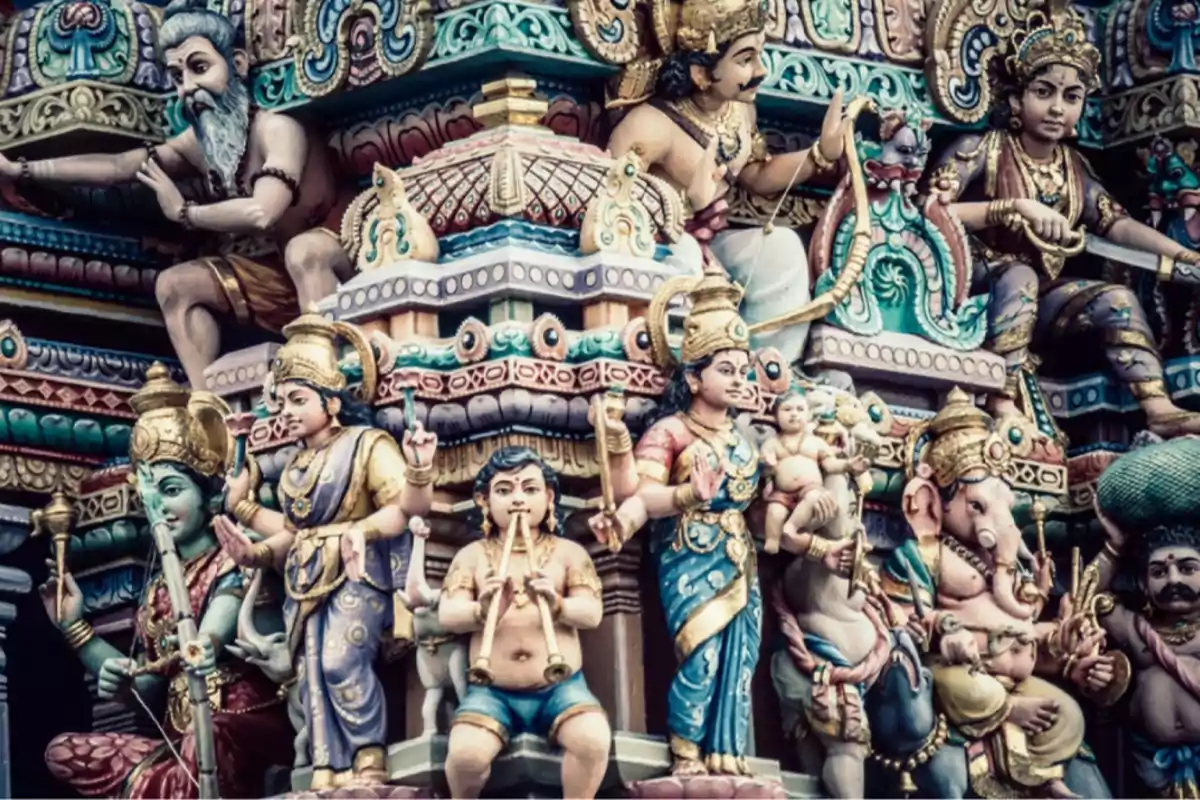Mythologies are the vehicle through which various civilizations have attempted to understand the creation of the world, the emergence of natural phenomena, and the existence of gods. Below you can discover a series of mythological narratives about the origin of the Milky Way, the attributes of a god, or the birth of man.
Popular Theogonic Myths and Their Origin
From Taoist cosmogony and Greek myths to the more exotic narratives of Norse mythology and the legends of Native Americans. Don't miss the following stories, each more enriching than the last.
1. The Birth of the Milky Way
The Greeks used to spend a long time gazing at the sky, and as good astronomers, mythology served them to name the stars. This is the origin of the myth about the creation of the Milky Way, which grants such privilege to Hera, wife of Zeus.
The most widespread version of the myth in Greek cosmogony says that Hera, jealous of her husband Zeus's love affairs, the god of gods, tried to thwart the birth of Hermes, a hero of classical Greek mythology.
He was born from the union of Zeus with Alcmena, daughter of King Electryon of Mycenae, and after lying with Zeus, she also lay with her husband, Amphitryon. She thus became pregnant by both, carrying in her womb Heracles, son of Zeus, and Iphicles, son of Amphitryon. Hera's wrath erupted when Zeus recognized Heracles, still unborn, as his favorite son.
So she set out to prevent the birth of that demigod at all costs. When Heracles was born, after six months, Hera sent two snakes that the child strangled, showing supernatural strength. Despite his strength, Heracles was mortal, and he could only achieve the immortality of the gods by nursing from Hera's breasts.
Hermes, the messenger god, brought Heracles to Hera, and he began to nurse while the goddess slept. Upon waking and seeing Heracles at her breasts, Hera pushed him away abruptly, but her milk continued to flow and spread across the universe.

2. The Eight Immortals of Taoism
The pantheon of Taoist gods, one of the most popular religions in China, is composed of the eight immortals, who achieved immortality through alchemy and acquired a series of attributes that make them deities.
Lu Dongbin is the master of the other immortals, the wisest and the protector of the sick, who wards off evil spirits and misfortune with his sword. Lan Caihe is a hermaphrodite god with no determined sex, adorned with bamboo canes and flowers, protector of florists and horticulturists.
Zhang Guo Lao is an elder who ensures wisdom and longevity, while He Xiangu is the female deity associated with the lotus flower, guarantor of physical and mental health. Han Xiangzi is the guardian of the secrets of alchemy, and Li Tieguai, with his disheveled appearance, protects the weakest and those in need of help.
The pantheon of the eight immortals also includes Zhongli Quan, who has the surprising ability to revive the dead and transform stones into precious materials, and Cao Guojiu, who with his jade tablets represents theater.
3. The Legend of the Minotaur
This is one of the most popular theogonic myths of Greek mythology. Its antagonist is the Minotaur, a being engendered by the wife of King Minos of Crete, Pasiphae, and a white bull sent by Poseidon, the king of the sea. Half man, half bull, the Minotaur lived in a labyrinth where he fed on human flesh.
In reality, the Minotaur was a punishment from Poseidon to King Minos for having offended the gods. Intending to hide it, out of shame, Minos had it locked in the labyrinth and offered it each year seven men and seven women imposed as a tribute to the city of Athens (which had lost the war against Crete).
The brave heir to the Athenian throne, Theseus, volunteered to enter the labyrinth, defeat the Minotaur, and free his city from such a tragic tax. Upon arriving in Crete, King Minos's daughter, Ariadne, fell madly in love with Theseus and gave him an invisible thread provided by Daedalus, the builder of the labyrinth.
Thus Theseus, after killing the beast, could find his way out and reunite with his beloved. And so it happened, closing the myth with a happy ending.
4. The Birth of Sleipnir
According to Norse mythology, the wall of Asgard, the abode of the gods, had been destroyed and they were at the mercy of the giants. A builder offered to erect a sturdy wall in sixteen months, asking only in return for the goddess Freya, the Sun, and the Moon.
The gods were enraged at such audacity, but Loki, the trickster giant, told the gods that if he could build the wall in just six months, it would be accepted. The gods agreed, and using his horse Svadilfari, he carried the stones from one place to another with surprising speed. When the deadline was almost up, the wall was nearly complete.
The gods, frightened, did not want to give up the beautiful Freya, much less the Moon and the Sun. They asked Loki for help, and he gave them the key: without his steed, the builder could not complete his work. Loki, disguised as a mare, led the horse away, and the builder, realizing it, flew into a rage with such irritation that his disguise fell off: he was actually a giant.
Thor gave him his due with a hammer blow to the head, and Loki returned as a pregnant mare, giving birth to an eight-legged horse named Sleipnir, which he gave as a gift to Odin, promising that it would carry him faster than anyone else by land, sea, and air.

5. A Native American Myth
On their way home, a group of hungry Native Americans dispersed to find food, and one of them, pressing his ear to the ground, believed he heard a herd of buffalo approaching. The group prepared to attack, with the leader at the head. However, what appeared was not buffalo but a giant snake.
After killing and cooking it, the Native Americans claimed that the meat of that snake was tastier than that of the buffalo, and all ate contentedly except for a child who accompanied the group. At midnight, the tribe's chief awoke horrified to see all his companions turned into snakes.
Even his own body had begun to transform into a snake. They all surrounded the child but, instead of eating him, they gave him all their amulets and asked him to leave them on a peak, under some trees.
The child returned to the village with a message: the snake-warriors would visit their families in the summer, and so they did. And when winter came, they disappeared forever with their horses and their tasks.
6. Horus Against Seth
According to Egyptian mythology, before dying, Osiris had been a mythical king, founder of the nation, and a wise and kind ruler. During his reign, Osiris visited territories and instructed farmers in cultivation, which earned him more and more followers everywhere. But while he traveled, his brother Seth, envious, took his throne.
The myth says that in a struggle for the dominion of Egypt, Seth killed his brother and cut him into pieces, scattering them throughout Egypt. Isis gathered the pieces and joined them to embalm him and bring him back to life. Thus she conceived Horus, who was destined to avenge his father's death with the assistance of the god Ra.
When he was ready, his father helped him gather an army and transformed into a giant to save the ships from the storm sent by Seth, ultimately killing him by shooting a harpoon into his mouth, which had turned into a hippopotamus.
Short Theogonic Myths
There are other short theogonic myths that condense into one or two paragraphs extraordinary narratives about the origin of the gods or their action in nature and men. We gather here Buddhist, Aztec, Greek, and Mesopotamian mythology.
7. Ometéotl, the God Who Created Himself
According to Aztec mythology, Ometéotl is the god who invented himself to originate everything else. His source is a mix of chaos and order, life and death, white and black, and a whole series of antagonists that give him the power to create and destroy. The ultimate representation of balance, he is the only deity that doesn't participate in human affairs.
8. Brahma and the Immortality of Man
Hindu mythology says that initially, men were immortal, but Brahma stole such privilege from them due to their bad behavior. He met with other gods to decide where he would hide mortality, and after much thought, he had a brilliant idea: in the only place where man would never look for it, within his own being.
Since then, man lives in ignorance of carrying immortality within himself.

9. The Origin of Fortune
The goddess Fortune, daughter of Zeus, had been trained by Mercury to run faster than anyone. Her father had entrusted her with a task: to travel the entire earth every dawn to collect the fruits of immortality consumed by the gods before the first rays of the sun destroyed them.
When a human crossed paths with her, the gods feared losing their food, so they granted a wish to be released. Hence the origin of Fortune.
10. The Mesopotamian Myth of the Creation of the World
The Mesopotamian civilization was born around the river, survived thanks to the river, and always grew with the river as a reference. Therefore, according to their beliefs, chaos was an immense ocean, and the world originated from the fusion of two rivers: the deities Tiamat and Apsu, fresh water and saltwater. From their union came the first gods.

